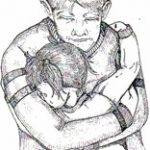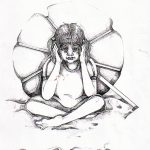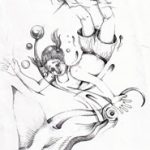Young readers who have found their own way to this page because they enjoyed the story – welcome. Try some of the exercises below.
For Classroom teachers: Target audience – for younger readers as a ‘read to’ story and for able readers as a first novel for 7 yrs to 10 +.
The activities offer some leeway according to children’s readiness for more formal aspects of narrative.
Please view the terms and conditions relating to the content of this website.



Dreamstone Notes
In stories we come to know our characters by what they say and how they say it. We come to know them by what they do and also what they think.
Thoughts often appear in Italics (running writing).
Questions a writer asks:
- Who is this little girl, sitting cross-legged in the sand away from her cousins who are having fun?
- What does she fear?
- What does she wish for?
- When she finds the stone, what are her actions?
- What happens along the way?
Activity suggestion: Think about Lucy and her family. do a character chart for this story with drawings and name labels.
A writer finds words for the different way people use their voices or gestures.
Yes Dad, Lucy said, meekly. What do you think that means?
Usually a writer will say, he said or she said, but sometimes, the way people use their voices shows how that character is feeling, as in:
‘I want a Kool-mint,’ Jack whined….
‘Don’t eat it!’ Lucy screamed. (from the chapter called “The Word-Cave Mishap”.
Activity suggestion: make a word chart of words that show the feeling behind words: e.g. yell, shout, screech, whisper, mumble….
A writer finds words for the way people move. Lucy trudges over the sand. Does that tell you something about how she is feeling? How do people move? Watch and see.
Activity suggestion: Make a chart with a list of words for the way people move. How many words can you find as a class? A person might march, stride, limp, trot, totter. Do these tell you something about them?
Discussion Points
- Guess what the story is about by looking at the cover and flicking through the chapter headings and illustrations.
- Jot down your predictions.
- Read the story for enjoyment: what surprised or amazed you?
- Think about place (the setting). In a few words describe ‘The Bay’ and draw a picture.
- Add the characters to your picture with labels.
- How important is the place to this story? Would it be quite the same story in another setting?
On Character and Plot
How do the character’s wishes shape the story? For example what brought Sharni down to The Bay?
What happens when two people want different things? (Lucy and her Dad in ‘I Wish’; Lucy and Jack in ‘Secrets’; Lucy and Thomas in ‘Sea Danger’ and Lucy and Sharni in ‘A New Journey’ .)
Families
How does Lucy feel about the family at the beginning of the story? Do her feelings change?
Think about: Lucy and her dad. Look at the picture on page 37. What does it tell you? Do you think her Dad loves her? Do you think she loves her Dad?
Remember how Lucy felt about Jan at the beginning of the story? How did that change when Jan tucked her into bed? Read the last two paragraphs on page 48.
Friendship
Read the first few pages of the chapter – I Wish.
When Ella doesn’t choose her for the team, how does Lucy feel?
What happens when Lucy and Ella talk to each other about how they feel? (Read page 52-54).
Setting
The setting in Dreamstone is The Bay – Gran’s house and at the end, in the aeroplane when Lucy and little brother Jack fly back to their mum in New York. Can you imagine it as Lucy sees it at the beginning of the story and then in the final chapters of the story when she and the cousins make sand sculptures? How does it change?
Fulfilling Dreams
Read the last chapter. Do you think Lucy will become a writer when she grows up? What is your dream?
Movement
Some words about how the sea creatures move in this story:
- Three blue-barred parrot fish darted over the coral.
- The stingray hovered above and then it glided over the reef.
Some every-day words help move the story along. There are a lot of ‘everyday words’ that help keep a story flowing. Here are two:
- Meanwhile tells you about something else that is happening just then. It helps move the scene along to something else, a bit like you see in movies.
- While the cousins played Lucy sat alone. This lets you know there are others present, but it brings the story back to Lucy.
Writing Exercises
Imagine finding your own special person you could talk to knowing she or he will understand. What questions would you ask? What stories might you tell to tell her about yourself?
Describe your own vision of a dreamstone.
Activity suggestion: Think about the bay or a place you know and love: write a poem, a letter, or tell a story about your own special person and place.
Write about swimming under water with eyes open (goggles on perhaps): what might you see?
More Writing Exercises
- Imagine you have your own magic stone in the palm of your hand – what does it feel like? What colour? What shape? What temperature? How many details can you think of? What do you see when you look into its surface?
- Describe your own magic stone and draw a picture.
- Make a magic stone in plasticine, clay, play dough or other pliable material.
- Make a nest with recycled material or with natural objects like twigs, leaves and grass.
- Write a poem about your magic stone – rhymed or unrhymed.
- Write an imaginary conversation with your magic stone.
- Write a self portrait for your stone – add as many things as you can think of that interest you – your likes and dislikes, your favourite place, person, the things you love best, the things you fear most.
- Artwork: Do a face portrait of yourself for your magic stone.
- Describe your house and your street: the address and anything about it that stands out.
- Imagine you are a free spirit like Sharni flying across the world with your golden eyes looking ahead. What sounds might you hear – ocean, wind, birds: the sounds of a busy city?
- Make a poem or write a song about the sounds.
- With a group make music with percussion instruments.
- Write a story about Sharni’s next adventure with a beginning, middle and end.
Read your story through and fix anything you notice that should be fixed.
Have somebody else check your story.
Illustrate your story and share it with others.